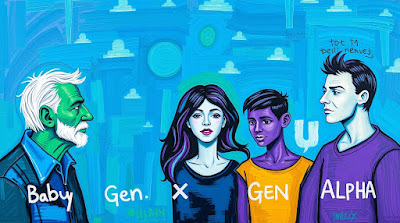 |
| A photo of the generational communication style |
Generational communication styles refer to the unique ways in which different age groups—such as Baby Boomers, Gen X, Millennials (Gen Y), Gen Z, and Gen Alpha—express themselves, interact, and exchange information. These styles are influenced by the historical, technological, and cultural context in which each generation grew up. Key factors include:
1.
Preferred Communication Channels: The platforms and
methods each generation favours (e.g., face-to-face, phone calls, email, social
media, instant messaging).
2.
Language Use: The tone, formality, slang, abbreviations, and use of visual
elements (emojis, GIFs, stickers) in communication.
3.
Speed and Expectations: The pace at which each generation
expects responses and their comfort level with real-time or asynchronous
communication.
4.
Technological Adaptation: The extent to which each generation
embraces or resists new technologies and digital tools.
Baby Boomers (Born 1946-1964)
- Analog Roots: Baby Boomers grew up with traditional forms of
communication like letters and landline phones.
- Platforms: Use email, Facebook, and occasionally WhatsApp. Some
may still prefer phone calls or face-to-face communication.
- Language Style:
- Formal & Polite: Tend to use more formal language and polite
expressions.
- Minimal Use of Emojis: Rarely use emojis or abbreviations.
- Long-Form Communication: Prefer detailed, well-thought-out messages or
letters.
- Face-to-Face Preference: Value in-person communication and may find digital
communication impersonal.
- Communication Speed: Expect responses but are generally more patient and
understanding of delays.
Gen X (Born 1965-1980)
·
Analog to Digital Transition: Gen X experienced the
shift from analog to digital communication.
·
Platforms: Use email, Facebook, and LinkedIn. Some may use WhatsApp or
text messaging.
·
Language Style:
o Formal & Direct: Tend to be more
formal and direct in their communication.
o Less Use of Emojis: Use emojis sparingly,
if at all.
o Professional Tone: Often maintain a professional
tone, even in informal settings.
o Preference for Phone
Calls:
More likely to prefer phone calls over text messages for important
conversations.
·
Communication Speed: Expect responses within a reasonable
time frame but are more patient than younger generations.
Millennials / Gen Y (Born 1981-1996)
·
Tech-Savvy but Not Digital Natives: Millennials witnessed
the rise of the internet and social media but adapted to it rather than being
born into it.
·
Platforms: Use Facebook, Instagram, LinkedIn, and WhatsApp.
· Language Style:
o Emojis &
Abbreviations: Use emojis and abbreviations, but not as extensively as Gen Z.
o Professional &
Personal Balance: More likely to maintain a balance between professional and
informal communication.
o Nostalgia: Often reference 90s
and early 2000s pop culture.
o Long-Form Communication: Comfortable with both
short messages and longer emails or posts.
·
Communication Speed: Prefer timely responses but are more
patient than Gen Z.
Gen Z (Born 1997-2012)
· Digital Natives: Gen Z grew up with smartphones, social media, and instant
messaging. They are highly comfortable with digital communication.
·
Platforms: Prefer platforms like Instagram, Snapchat, TikTok, and Twitter
(X).
·
Language Style:
o Abbreviations &
Acronyms: Frequent use of abbreviations (e.g., "idk" for
"I don't know," "tbh" for "to be honest").
o Emojis & GIFs: Heavy use of emojis, stickers, and GIFs to convey emotions and reactions.
o Slang: Use of contemporary
slang (e.g., "yeet," "sus," "vibe check").
o Informal Tone: Casual and conversational,
often with a humorous or sarcastic undertone.
· Communication Speed: Expect quick responses and often engage in rapid, back-and-forth exchanges.
Gen Alpha (Born 2013-Present)
·
True Digital Natives: Gen Alpha is growing up in a world
dominated by smartphones, tablets, and voice-activated assistants.
·
Platforms: Use platforms like YouTube Kids, TikTok, and gaming platforms
(e.g., Roblox).
·
Language Style:
o Visual & Voice
Communication: Prefer visual content (videos, images) and voice messages over
text.
o Early Adoption of Slang: Even at a young age,
they pick up on slang and trends from older siblings or the internet.
o Interactive Content: Engage with
interactive content like polls, quizzes, and games.
o Emojis & Stickers: Heavy use of emojis,
stickers, and other visual elements to communicate.
·
Communication Speed: Expect instant responses and are highly
adept at multitasking across multiple platforms.
Key Differences:
· Formality: Older generations tend to be more formal, while younger
generations favour informal, casual communication.
· Use of Technology: Younger generations are more likely to use the latest
technology and platforms, while older generations may stick to more traditional
methods.
· Speed of Communication: Younger generations expect faster responses
and are more comfortable with rapid, real-time communication.
· Visual vs. Textual: Younger generations prefer visual and interactive content,
while older generations may prefer textual or verbal communication.




.png)




.png)






0 Comments